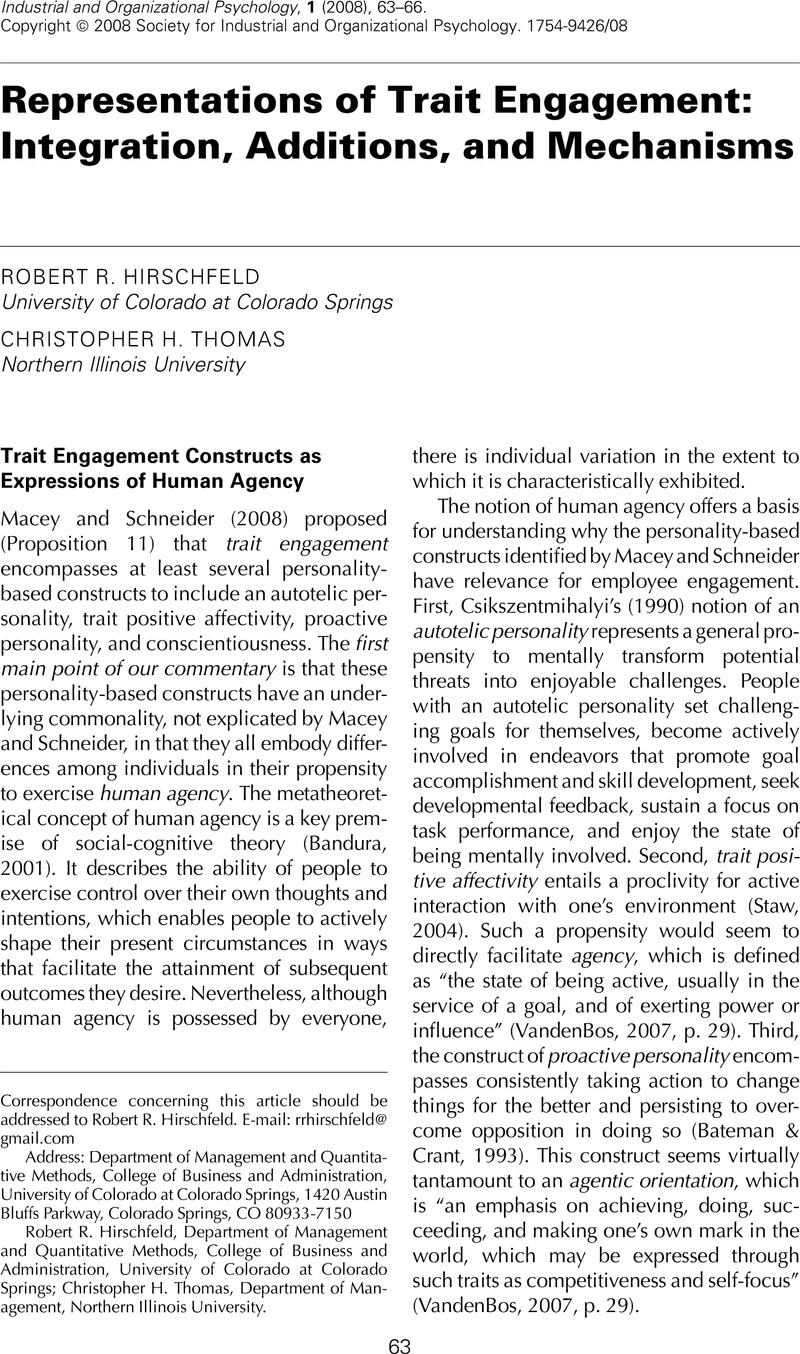Crossref Citations
This article has been cited by the following publications. This list is generated based on data provided by Crossref.
Macey, William H.
and
Schneider, Benjamin
2008.
Engaged in Engagement: We Are Delighted We Did It.
Industrial and Organizational Psychology,
Vol. 1,
Issue. 1,
p.
76.
Hirschfeld, Robert R.
Thomas, Christopher H.
and
Bernerth, Jeremy B.
2011.
Consequences of autonomous and team-oriented forms of dispositional proactivity for demonstrating advancement potential.
Journal of Vocational Behavior,
Vol. 78,
Issue. 2,
p.
237.
CHRISTIAN, MICHAEL S.
GARZA, ADELA S.
and
SLAUGHTER, JEREL E.
2011.
WORK ENGAGEMENT: A QUANTITATIVE REVIEW AND TEST OF ITS RELATIONS WITH TASK AND CONTEXTUAL PERFORMANCE.
Personnel Psychology,
Vol. 64,
Issue. 1,
p.
89.
Shuck, Brad
2011.
Integrative Literature Review: Four Emerging Perspectives of Employee Engagement: An Integrative Literature Review.
Human Resource Development Review,
Vol. 10,
Issue. 3,
p.
304.
Shuck, Brad
Ghosh, Rajashi
Zigarmi, Drea
and
Nimon, Kim
2013.
The Jingle Jangle of Employee Engagement.
Human Resource Development Review,
Vol. 12,
Issue. 1,
p.
11.
Shuck, Brad
Osam, Kobena
Zigarmi, Drea
and
Nimon, Kim
2017.
Definitional and Conceptual Muddling: Identifying the Positionality of Employee Engagement and Defining the Construct.
Human Resource Development Review,
Vol. 16,
Issue. 3,
p.
263.
Haynie, Jeffrey Joseph
Flynn, C. Brian
and
Mauldin, Shawn
2017.
Proactive personality, core self-evaluations, and engagement: the role of negative emotions.
Management Decision,
Vol. 55,
Issue. 2,
p.
450.
Young, Henry R.
Glerum, David R.
Wang, Wei
and
Joseph, Dana L.
2018.
Who are the most engaged at work? A meta‐analysis of personality and employee engagement.
Journal of Organizational Behavior,
Vol. 39,
Issue. 10,
p.
1330.
Ben Ayed, A.K.
and
Vandenberghe, C.
2018.
Engagement au travail, estime de soi organisationnelle, et satisfaction envers la carrière : une étude prospective.
Psychologie du Travail et des Organisations,
Vol. 24,
Issue. 2,
p.
203.
Doo, Min Young
Zhu, Meina
Bonk, Curtis J.
and
Tang, Ying
2020.
The effects of openness, altruism and instructional self‐efficacy on work engagement of MOOC instructors.
British Journal of Educational Technology,
Vol. 51,
Issue. 3,
p.
743.
Haynie, Jeffrey
Flynn, C. Brian
and
Herda, David
2020.
Linking career adaptability to supervisor-rated task performance: a serial mediation model.
Career Development International,
Vol. 25,
Issue. 4,
p.
429.
Fahdha Razzaq
and
Sadaf Razzaq
2021.
PERCEIVED PERSONALITY CHARACTERISTICS RELATION WITH WELL-BEING AMONG ADULTS.
The Mind-Journal of Psychology,
Vol. 1,
Issue. 1,
p.
19.
Panditharathne, Panditharathne Nishantha Kumara Wijesekara
and
Chen, Zhixia
2021.
An Integrative Review on the Research Progress of Mindfulness and Its Implications at the Workplace.
Sustainability,
Vol. 13,
Issue. 24,
p.
13852.
Li, Jian-Bin
Leung, Iris Tuen Yung
and
Li, Zhouxing
2021.
The pathways from self-control at school to performance at work among novice kindergarten teachers: The mediation of work engagement and work stress.
Children and Youth Services Review,
Vol. 121,
Issue. ,
p.
105881.
Baldissarri, Cristina
and
Andrighetto, Luca
2021.
Being Treated as an Instrument: Consequences of Instrumental Treatment and Self-Objectification on Task Engagement and Performance.
Human Performance,
Vol. 34,
Issue. 2,
p.
85.
Wang, Can
Wei, Yongchang
Zhao, Xuan
Zhang, Xuan
and
Peng, Ye
2021.
Abusive Supervision and Creativity: Investigating the Moderating Role of Performance Improvement Attribution and the Mediating Role of Psychological Availability.
Frontiers in Psychology,
Vol. 12,
Issue. ,
Ababneh, Omar Mohammed Ali
2021.
How do green HRM practices affect employees’ green behaviors? The role of employee engagement and personality attributes.
Journal of Environmental Planning and Management,
Vol. 64,
Issue. 7,
p.
1204.
Sim, Max
Conduit, Jodie
Plewa, Carolin
and
Hentzen, Janin Karoli
2022.
Customer engagement with service providers: an empirical investigation of customer engagement dispositions.
European Journal of Marketing,
Vol. 56,
Issue. 7,
p.
1926.
Kumar, Puneet
and
Padhi, Nayantara
2022.
Development and validation of multi-factor employee engagement measuring instrument: a formative measurement model.
Personnel Review,
Vol. 51,
Issue. 9,
p.
2261.
Okojie, Glory
Alam, A.S.A. Ferdous
Begum, Halima
Ismail, Ida Rosnita
and
Sadik-Zada, Elkhan Richard
2024.
Social support as a mediator between selected trait engagement and employee engagement.
Social Sciences & Humanities Open,
Vol. 10,
Issue. ,
p.
101080.


